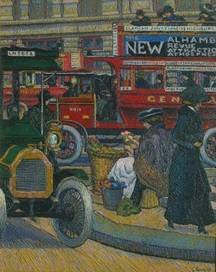Modern Painters
dal 12/2/2008 al 4/5/2008
Segnalato da
Walter Sickert
Charles Ginner
Spencer Gore
Harold Gilman
Robert Bevan
Karla Black
Alice Channer
Dee Ferris
Anthea Hamilton
Katy Moran
Breda Beban
Robert Upstone
12/2/2008
Modern Painters
Tate Britain, London
The Camden Town Group

Modern Painters: The Camden Town Group is the first exhibition for twenty years to focus on the work of a circle of painters who were a leading force in modern British art in the years leading up to, and during the First World War. Founded by Walter Sickert in 1911, the Groupchronicled changes in both British society and the rapidly developing city of London, depicting a powerful portrait of a nation in transition. Comprising over one hundred paintings the exhibition will bring together works by core members of the Group including Charles Ginner, Spencer Gore, Harold Gilman, and Robert Bevan. An important selection of key works by Sickert, including ‘The Camden Town Murder’ series, will be displayed.
The exhibition will explore how these artists responded to and captured the shared experience of modern life. Works such as Gilman’s Mrs Mounter at the Breakfast Table, c.1917 (Tate Collection), depict individuals in everyday domestic situations while Gore’s Balcony at the Alhambra, c.1911-12 (York City Art Gallery) highlights the vibrant popular culture of the music hall and Ginner’s Piccadilly Circus 1912 (Tate Collection), records the crowded centres and traffic-choked streets of the changing city.
Modern Painters will look at how the Group’s choice of everyday subjects from urban life, and their bold, anti-naturalistic colouring presented a type of painting that was new and different in the London of 1911. Their distinctive style developed the possibilities of recent French Impressionist painting – their subjects were painted in dry, thick, crusty paint, applied in broken touches, and Gore, Ginner, Gilman and Bevan adopted a vibrant Post-Impressionist palette with brilliant, vibrating colour combinations of mauves and pinks and greens, while Sickert used the darker, richer tones of the Old Masters.
The exhibition will show how the Group explored changing sexual attitudes of the time. Sickert, Gore and Gilman in particular created images of women that were more overtly sexual in content than anything being produced in France, a frankness that reflected the contemporary writing of H.G. Wells, D.H. Lawrence and Rebecca West.
Some of the group were also drawn to the countryside and depicted views of unspoilt landscapes. Gore, Bevan and Ginner were regular visitors to Applehayes Farm Estate in Devonshire – a traditional English agricultural society within a wild landscape. Paintings such as Bevan’s A Devonshire Valley No.1c.1913 (Royal Albert Memorial Museum & Art Gallery) not only affirmed the beauty of the British countryside, but through their contrast with images of the city, emphasised the march of modern life elsewhere.
The exhibition is curated by Robert Upstone, Curator (Modern British Art) at Tate Britain. A fully illustrated catalogue, edited by Robert Upstone and including essays by a number of contributing authors will accompany the exhibition (priced £24.99).
---
Art Now: Strange Solution
2 February – 13 April 2008
This exhibition brings together five artists whose paintings, sculptures and installations take found objects, images or substances as a starting point. They then amend, transform or juxtapose these existing things or matter so there is a sense of their original use or function but also a new relationship with each other and with the viewer. Through a process of reduction and abstraction, the resulting artworks have a minimalist, even impoverished aesthetic. Often the work has a very personal, 'lived' feeling and narratives are evoked but never spelled out. The artists are Karla Black, Alice Channer, Dee Ferris, Anthea Hamilton and Katy Moran.
----
Lightbox: Breda Beban
2 February – 30 March 2008
The new Lightbox series is dedicated to showing artists’ film and video. Breda Beban’s film installation The Most Beautiful Women in Gucha 2006 looks at the authenticity of documentary footage and how postproduction techniques can begin to turn it into fiction. Filmed at a raucous gathering of musicians in Serbia, the film captures the passionate encounter between a dancer and a young man. It reveals Beban’s preoccupation with the dynamics of love and relationships and the importance of gestures and performance.
For further press information please contact Helen Beeckmans or Louise Butler, Tate Press Office, Millbank, London, SW1P 4RG. Call 020 7887 8730/32 Email pressoffice@tate.org.uk
Admission £9 ( £7 concessions)
Opening hours: Tate Britain is open daily, 10.00–17.50
Exhibitions 10.00–17.40 (last admission 17.00)



